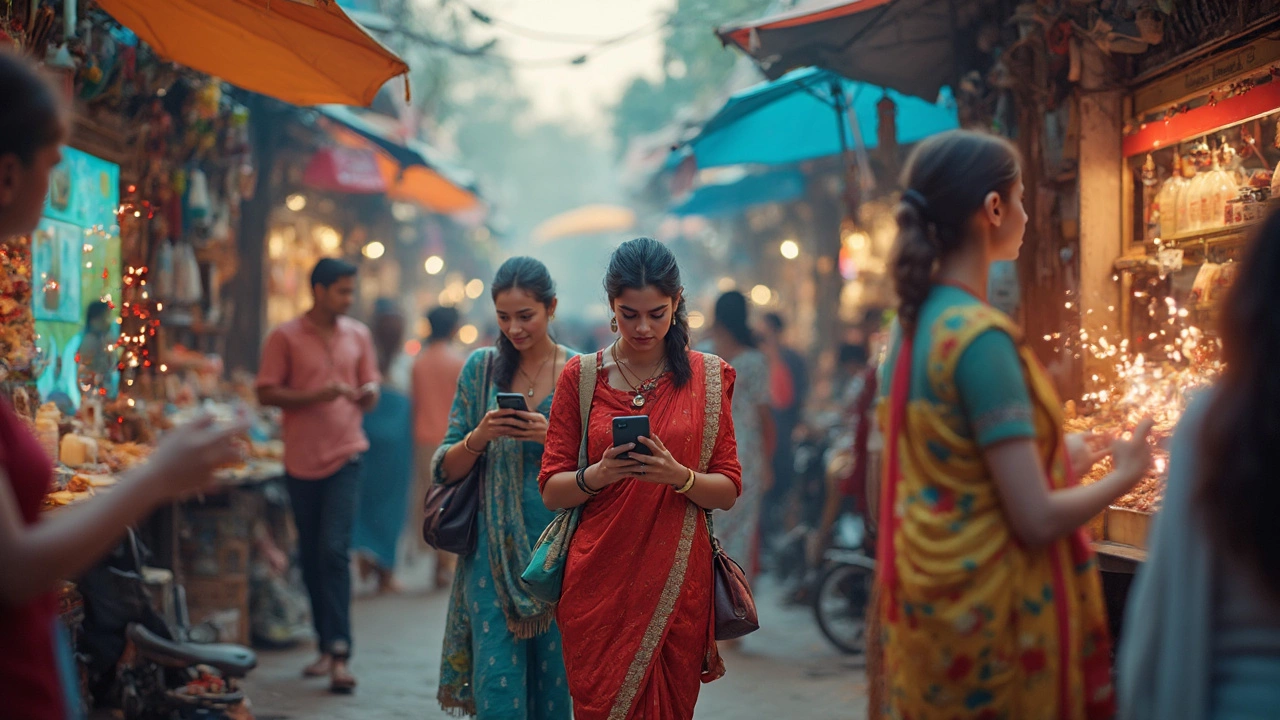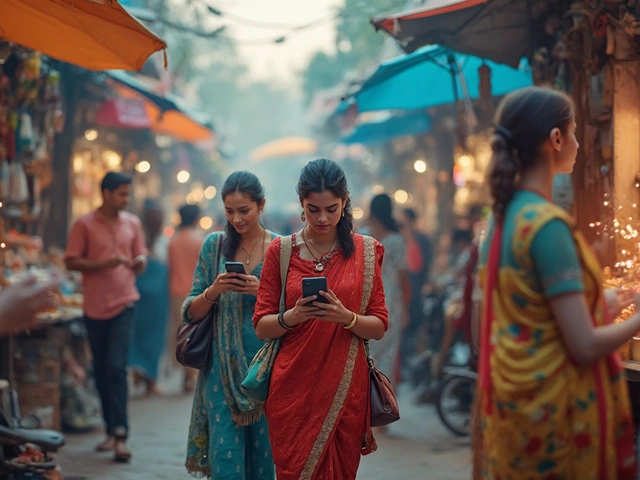It doesn’t matter if you’re launching a homegrown shop or scaling up a brand already selling online—you need to know what people in India can’t stop adding to their carts. Everyone wants a slice of the action, but only those who track product demand really get ahead.
The numbers are wild: India saw roughly 200 million online shoppers in 2024, with new buyers flooding platforms during every festival season. But not everything sells like hotcakes. While there’s a lot of noise around gadgets and fashion, it’s the combo of price, convenience, and a splash of trendiness that powers the biggest winners.
If you’re thinking smartphones, you’re onto something—budget and mid-range phones move faster than train tickets during Diwali, with brands like Xiaomi and Realme barely keeping up with orders. But it’s not just tech. Thanks to social media hustle, skincare and beauty products have exploded in demand, with homegrown D2C brands becoming household names. Curious about what else tops the charts? Stick around, because knowing these trends puts you miles ahead of average sellers.
- What Indians Are Buying Like Crazy
- Why These Products Dominate the Market
- How to Spot the Next Big Winner
- Tips to Crush It on Indian Ecommerce Platforms
What Indians Are Buying Like Crazy
If you think online shopping in India is all about fancy gadgets, you’re missing the bigger picture. Sure, electronics rack up the numbers, but there’s a lot more flying off the virtual shelves. Let’s get real with some specifics.
Smartphones are a classic favorite. No surprise—India is the second-largest smartphone market in the world. Every time there’s a flash sale on Mi or Realme, websites stumble under the pressure. In 2024 alone, about 175 million smartphones were sold online in India. But it’s not just the fancy new launches; budget-friendly options with solid specs usually win the race over high-end flagships.
Next up is fashion. From wedding-ready lehengas to affordable everyday tees, Indian buyers love a good deal and prompt delivery. Sites like Myntra, AJIO, and Flipkart are flooded with buyers, especially during festive sales and end-of-season clearances. Quick tip: western wear, street-style sneakers, and unbranded but trendy clothing move the fastest.
Beauty and personal care have gone mainstream, thanks to social media influencers and YouTube reviews. No longer limited to big brands, people now hunt for homegrown labels offering natural or ayurvedic options. A recent study from RedSeer Consulting notes,
"Beauty and personal care is witnessing 20% annual growth online in India, led by a young and curious buyer base."
Then, we have electronics accessories—think earphones, power banks, smartwatches, and fitness bands. Low price, fast delivery, big demand. These small-ticket items are easy impulse buys, especially for students and office-goers.
Here’s a quick snapshot of top-selling India ecommerce product categories between Jan 2024 and April 2025:
| Category | Online Sales Share (%) |
|---|---|
| Smartphones | 28% |
| Fashion/Apparel | 26% |
| Beauty & Personal Care | 14% |
| Consumer Electronics | 12% |
| Home & Kitchen | 9% |
| Groceries | 7% |
Not to forget, grocery and daily essentials, especially after the pandemic. Even in smaller towns, people are now hooked to local delivery of fresh fruits, veggies, and snacks via platforms like BigBasket and Blinkit.
If you’re eyeing the fast-selling items on ecommerce platforms India loves, these categories should be your starting point. Watch what disappears from online stock first during big sales—chances are, you just found your next best-seller.
Why These Products Dominate the Market
Let’s get real—India ecommerce wouldn’t be blowing up without a few key reasons why certain products always lead the pack. For starters, price matters—a lot. Most shoppers in India have a tight budget, so brands that offer good-quality high demand products at affordable rates (think Redmi smartphones or Mamaearth skincare) pull in crowds. These aren’t luxury items, but they feel like small wins for buyers who want value for their money.
Another huge factor? Internet access. India’s affordable data plans—thanks, Jio—mean millions more families shop from their living rooms. Shopping apps are easy to use, available in local languages, and packed with deals on stuff people actually need: clothes, electronics, and now, even groceries.
Social media is powering a lot of these online shopping decisions. Young Indians scroll through Instagram, see their friends or influencers raving about a product, and then buy it with just a couple of clicks. It’s not just fashion—everything from trendy kitchen gadgets to protein supplements gets its moment in the spotlight. Many D2C brands start selling exclusively online and use social platforms to build loyal fanbases who trust their word over a glitzy TV ad.
Fast shipping from major ecommerce platforms like Flipkart and Amazon is another deal-breaker. Next-day or even same-day delivery isn’t a luxury anymore; customers expect it, especially for time-sensitive stuff like mobile phones during launch sales or personal care products ahead of festivals.
| Category | Top Seller | Why It Sells |
|---|---|---|
| Smartphones | Xiaomi Redmi Series | Affordable, reliable, feature-packed |
| Skincare | Mamaearth Face Wash | Homegrown, natural, social media buzz |
| Casual Wear | Roadster T-shirts | Trendy, cheap, frequent offers |
Most important, buyers trust brands with strong customer service—returns, refunds, and replacements must be hassle-free. When platforms and sellers nail this, people keep coming back and even recommend these stores to friends and family. So, if you want to sell something online, get these basics right and watch your products take off.

How to Spot the Next Big Winner
So, how do you find the next high demand products that will rule the India ecommerce space? There’s no secret formula, but some practical moves stack the odds in your favor. If you don’t want to end up with dead stock, pay attention to what’s trending, what’s missing in the market, and—most importantly—how people are actually shopping.
Here’s what separates a one-hit wonder from a long-term bestseller:
- Watch the Data, Not Just the Hype: Google Trends and platforms like Meesho or Amazon sell reports are goldmines. You can literally see search spikes for things like "fragrance-free face wash" or "wireless earphones under ₹1000." If searches and buys are moving, so should you.
- Ride Seasonal Waves: Product demand in India explodes during events like Diwali, wedding season, or back-to-school. Last year, cosmetics and smart accessories grew by over 40% in the weeks before major festivals. Set calendar reminders to spot these waves.
- Scroll Social Like It’s Research: Instagram Reels, YouTube unboxing videos, and even WhatsApp forwards sometimes tell you what’s hot before the mainstream catches on. Many D2C beauty brands blew up after viral videos. If your feed is filled with a product, chances are your customers’ feeds are too.
- Read Product Reviews: Five-star reviews aren’t just fluff—they reveal what people actually value. Maybe it’s “long battery life” in earbuds or “no harsh chemicals” in shampoo. That’s your cue to double down on those features in your own listings or stock picks.
- Track Out-of-Stock Items: Products going out of stock repeatedly (especially on high-traffic sites) show the demand is real and probably underserved. Tools like Keepa or browser extensions for price tracking can help you spot these trends before everyone else.
If you want to geek out for a sec, check out this quick look at fast-rising categories from 2024 according to ecommerce sales data:
| Category | YoY Growth | Hot Products |
|---|---|---|
| Electronics | 28% | Budget smartphones, true wireless earphones |
| Personal Care | 32% | Natural hair oils, skincare |
| Home & Kitchen | 24% | Smart bulbs, air fryers |
| Fashion Accessories | 20% | Smartwatches, imitation jewelry |
Jumping on a trend is cool, but don’t lose sight of fit—does this product make sense for your brand, your logistics, and the customers you want? Use these steps, keep your antennae up, and you’ll spot winners ahead of the pack in the online shopping race.
Tips to Crush It on Indian Ecommerce Platforms
If you want to stand out on India ecommerce platforms, you can't just dump your products online and hope for the best. Success comes down to smart moves, timing, and knowing exactly how Indian shoppers behave. Here's what actually works:
- Punchy Product Listings: Use real photos and honest info—no heavy filters or fake specs. Titles packed with high demand products keywords help you get found. Keep your descriptions short and clear, but don’t leave out what makes your item special.
- Master the Timing: India's shopping game goes into overdrive during festivals—think Diwali, Raksha Bandhan, and back-to-school months. Plan big sales, boost your ad budget, and pile up stock days before the rush, not after.
- Fast Shipping Wins Buyers: Indian customers expect lightning delivery, especially in metros. If you can offer one- or two-day shipping, say it loud on your product page. Use fulfillment by marketplaces like Flipkart and Amazon or team up with local courier services for speed outside the main cities.
- Feedback Is Gold: Shoppers read reviews before buying. Request feedback right after delivery and respond to complaints ASAP. Tons of good ratings mean more trust and higher rankings on online shopping platforms.
- Use Cash on Delivery: Around 55% of shoppers still prefer Cash on Delivery, especially in tier-2 and tier-3 cities. Don’t skip this option unless you want to miss half your potential orders.
- Target Trending Categories: Get on board with fast-selling items like affordable electronics, skincare, fashion, and home improvement gadgets. Fast-selling items in these areas stay hot thanks to social media and influencer buzz.
- Keep Prices Competitive: Compare your rates to top sellers daily. Shoppers will drop out of your funnel over 100 rupees, often at checkout. Use platform deals and offers to appear on the main app banners.
Here's a quick look at the most popular product categories by order volume in 2024 across Indian ecommerce:
| Category | Order Volume % |
|---|---|
| Smartphones | 32% |
| Fashion | 24% |
| Beauty & Skincare | 15% |
| Home Essentials | 12% |
| Electronics Accessories | 8% |
If you follow these practical tips, you’ll do more than just sell products—you’ll build trust, gain repeat customers, and seriously boost your reach on every major Indian ecommerce trends chart.


